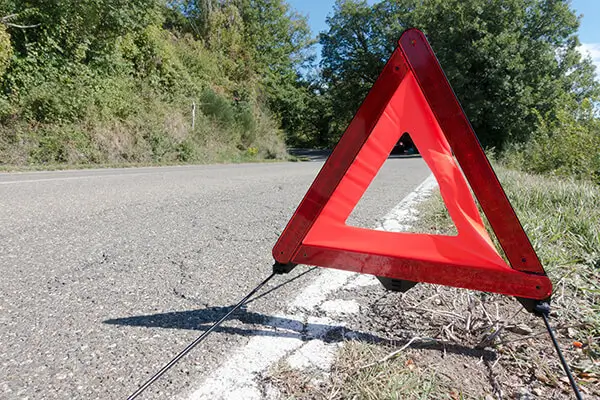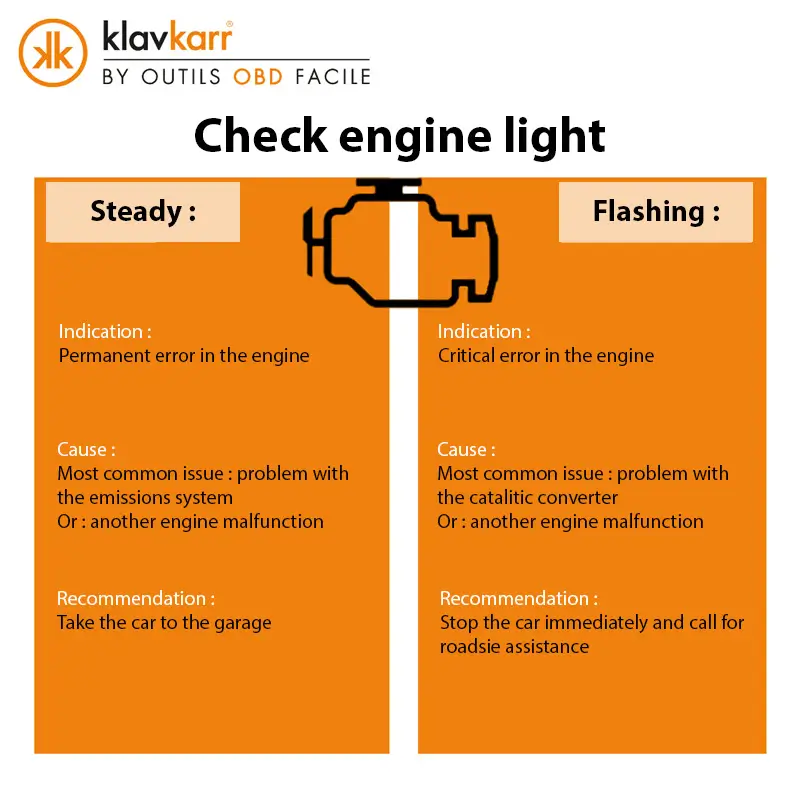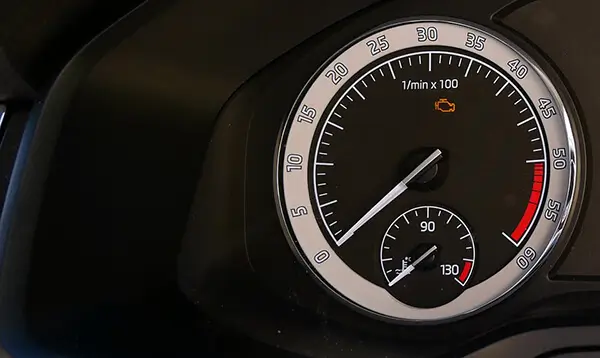The check engine light is one of the most important indicators on your dashboard. It can signal a variety of issues, ranging from a loose gas cap to a more serious problem like engine misfires.
What is the purpose of the check engine light?
A check engine light turning on is never a good sign.
What are the most common reasons that trigger this warning light?


Are you looking for a car scanner ?
The check engine light is on
The engine is made up of multiple components, so the light may appear on the dashboard for various reasons.
What the check engine light indicates
The check engine light may appear on the dashboard at different times while driving:
- When you turn on the ignition: All dashboard warning lights briefly illuminate and then turn off after checking that the systems are functioning correctly.
- While driving: This is more concerning, as it indicates that the engine control unit (ECU) is not receiving accurate data or, worse, no data at all.
Can you drive with the check engine light on?

Since the check engine light warns of an engine system issue, seeing it turn on is never reassuring. However, this does not necessarily mean the problem is critical. So, can you still drive?
If you see the check engine light turn on, the first thing you should do is consult the car’s manual. It often contains a list of possible reasons why the check engine light may be on.
If the manual does not provide an answer or the issue persists, it is best to take your car to a qualified mechanic for a diagnostic check or use a diagnostic scanner yourself to determine the cause of the issue.
Ignoring the check engine light can lead to further engine damage, so it is important to take action as soon as possible.

Are you looking for a car scanner ?
Is it dangerous to drive with a flashing check engine light?
If the check engine light is flashing, the risk is high that the fault detected by the ECU could cause serious engine damage.
If your check engine light is flashing, stop immediately and call for roadside assistance.
The different display modes: flashing vs. steady light
The way the light behaves can give you an idea of the severity of the situation.

Check engine light on but no noticeable issues
If your check engine light is on but you do not notice any problems, several factors could be causing it.
First, check all fluid levels and ensure they are at the correct levels. A low oil level, for example, can trigger the check engine light.
A clogged air filter can also cause the light to come on. If the filter is dirty, it can restrict airflow and reduce engine performance.
Finally, a loose gas cap can also trigger the check engine light.
Check engine light on and loss of power
When a significant fault is detected, the ECU may switch the engine to limp mode. This means the ECU drastically reduces engine performance to prevent further damage, such as complete engine failure.

Are you looking for a car scanner ?
Check engine light on with no loss of power
As mentioned earlier, the check engine light can turn on even if no noticeable issues are present or if there is no loss of power.
Three possible reasons why the check engine light is on
Faulty sensor
Engine operation relies on various sensors such as crankshaft, camshaft, knock, and mass airflow sensors. If any of these fail, the engine may enter limp mode, and the check engine light will appear on the dashboard.
Common symptoms include:
- Increased fuel consumption
- Engine vibrations
- Reduced engine power
In some cases, the engine may fail to start.

Fuel system malfunction
The fuel pump transports fuel from the tank to the injection rail via a fuel line. The injectors then spray the fuel into the combustion chambers.
The evaporative emissions control system prevents fuel vapors from escaping into the atmosphere. However, the check engine light can turn on if the gas cap is not properly tightened. A fault in any part of the fuel system can lead to engine failure, power loss, starting difficulties, etc.
If this happens, it indicates that the car's fuel system needs to be checked.
Faulty spark plugs or ignition coils
Spark plugs and ignition coils play a key role in igniting the air-fuel mixture in engine cylinders. In gasoline engines, the air-fuel mixture is ignited by an electrical spark that forms between the electrodes of the spark plugs.
If you experience any of the following symptoms, check your spark plugs and ignition coils:
- Increased fuel consumption
- Difficulty starting the engine or engine misfires

Are you looking for a car scanner ?
Conclusion
Seeing the check engine light on your dashboard does not always mean your engine is ruined. It could be something as minor as a disconnected sensor or, in a worst-case scenario, a severe engine failure. However, to be safe, it is best to consult an expert.
To learn more
Learn more
That’s it for this article on the different reasons why the check engine light may turn on. If you have any tips or questions, feel free to share them in the comments.
You can also share this article with your friends on social media!

